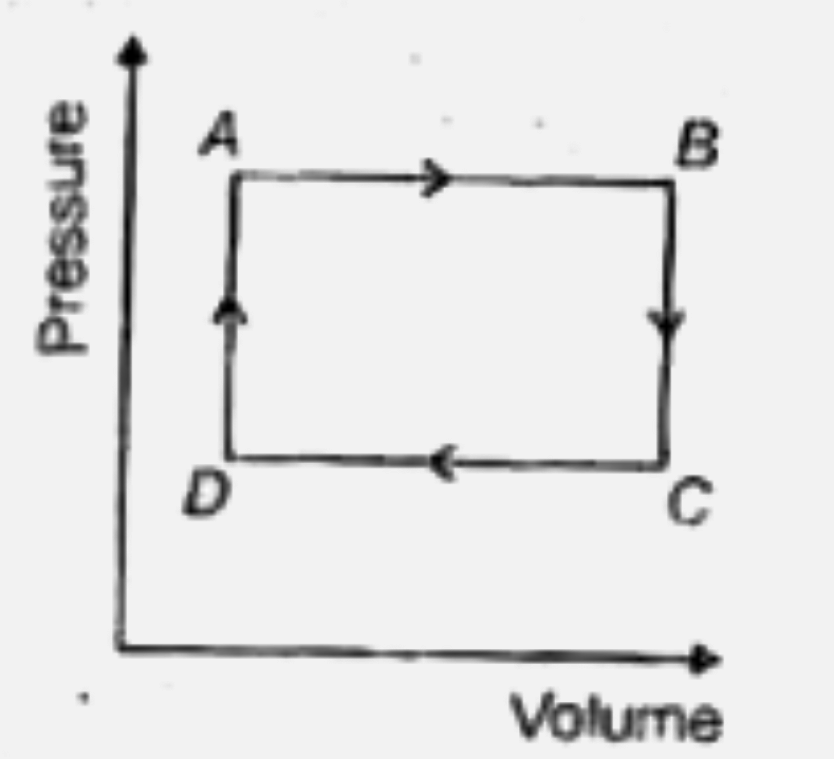An ideal gas is taken from the state A (pressure p, volume V) to the state B (pressure p/2, volume 2V) along a straight line path in the p-V diagram. Select the correct statement from the following
The work done by the gas in process A to B exceeds the work that would be done by it if the system were taken from A to B along the isotherm
In the T-V diagram, the path AB becomes a part of a parabola
In the P-T diagram, the path AB becomes a part of a hyperbola
In going from A to B, the temperature T of the gas first increases to a maximum value and then decreases
The correct Answer is:A, B, D
Work done by the gas in the process A to B exceeds the work that would be done by it if the system were taken from A to B along the isotherm. This is because the work done is the area under the P – V indicator diagram. As shown, the area under the graph in the first diagram will be more than that in the second diagram. When we extrapolate the graph shown in figure (a), let p0 be the intercept on the P-axis and V0 be the intercept on the V-axis. The equation of the line AB can be written as

p=−P0V0V+P0 [∵y=mx+c] ...(i)
To find a relationship between P and T, we use
PV=RT⇒V=RTP ...(ii)
From Eqs (i) and (ii),
P=P0V0×RTP+p0 ⇒ p2v0−pp0V0=−P0RT
Relation between P and T is the equation of a parabola.
Also PV = RT
∴ P=RTV ...(iii)
From Egs (i) and (ii).
RTV=−P0V0+P0 ⇒ RT=−P0V0V2+P0V ...(iv)
The above equation is of a parabola (between T and V)
T=−P0V0RV2+P0V
Differentiating the above equation w.r.t. V we get
dTdV=−P0V0R×2V+P0R
when dtdV=0
then p0V0R×2V=P0R⇒V=V02
Also d2Td2V=−2P0V0R=−Ve
⇒ V=V0/2 is the value of maximum of temperature
Also PAVA=PBVB⇒TA=TB (From Boyle’s law)
⇒ In going from A to B, the temperature of gas first increases to a maximum ( at V=V0/2) and the decreases and reaches back of the same value.
Topper's Solved these Questions
- GASEOUS STATE & THERMODYNAMICSBOOK - VMC MODULES ENGLISHCHAPTER - GASEOUS STATE & THERMODYNAMICSEXERCISE - JEE MAIN (ARCHIVE )
81 Videos
- ENERGY & MOMENTUMBOOK - VMC MODULES ENGLISHCHAPTER - ENERGY & MOMENTUMEXERCISE - JEE ADVANCE (ARCHIVE) - TRUE/FALSE TYPE
1 Videos
- GRAVITATIONBOOK - VMC MODULES ENGLISHCHAPTER - GRAVITATIONEXERCISE - JEE Advance (Archive) TRUE/FALSE
1 Videos
Similar Questions
An ideal gas is taken from the state A (pressure p, volume V) to the state B (pressure p2, volume 2V) along a straight line path in the p-V diagram. Select the correct statement(s) from the following.
View SolutionAn ideal gas is taken from the state A (pressure p, volume V) to the state B (pressure p2, volume 2V) along a straight line path in the p-V diagram. Select the correct statement(s) from the following.
View SolutionThe pressure and volume of a gas are changed as shown in the p-V diagram in the figrue ahead. The thmperature of the gas

View SolutionThe pressure p and volume V of an ideal gas both increase in a process.
View SolutionAn ideal monatomic gas is at P0,V0. It is taken to final volume 2V0 when pressure is P0/2 in a process which is straight line on P−V diagram. Then

View SolutionAn ideal gas has pressure P, volume V and temperature T. Select the correct option.
View SolutionThe pressure P and volume V of an ideal gas both decreases in a process.
View SolutionOne mole of an ideal gas is taken from state A to state B by three different processes (a) ACB, (b) ADB and (c ) AEB as shown in the P−V diagram. The heat absorbed by the gas is

View SolutionOne mole of an ideal gas is taken from state A to state B by three different processes (a) ACB, (b) ADB and (c ) AEB as shown in the P−V diagram. The heat absorbed by the gas is

View SolutionAn ideal gas undergoes an expansion from a state with temperature T1 and volume V1 through three different polytropic processes A,B and C as shown in the P−V diagram. If |ΔEA|,|ΔEB| and |ΔEC| be the magnitude of changes in internal energy along the three paths respectively, then :

View Solution
